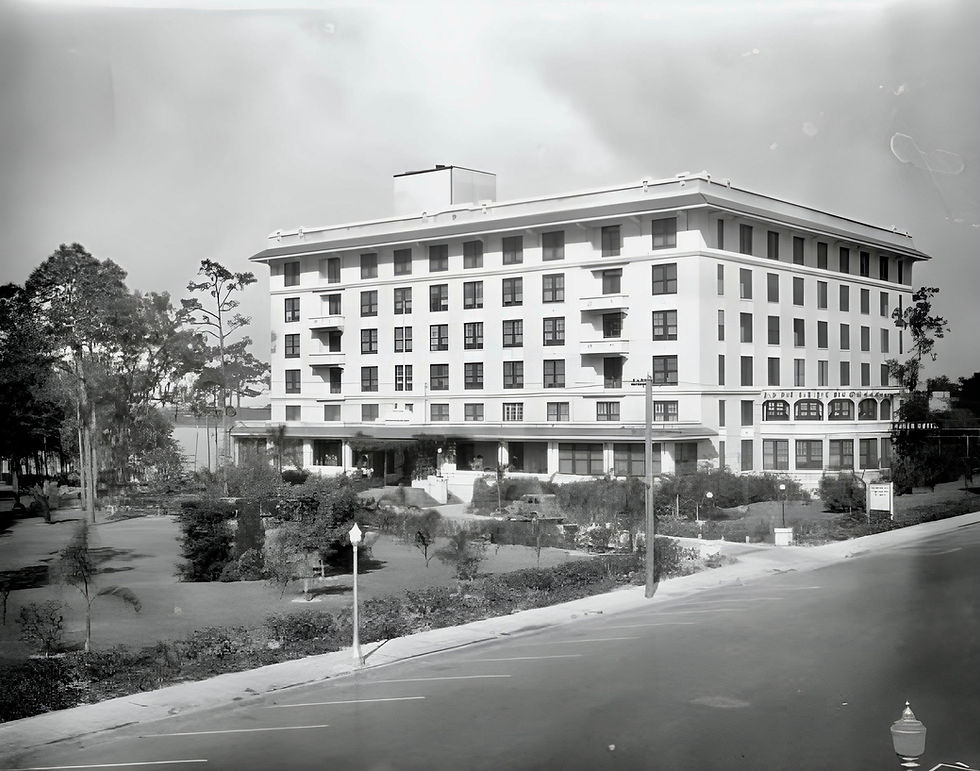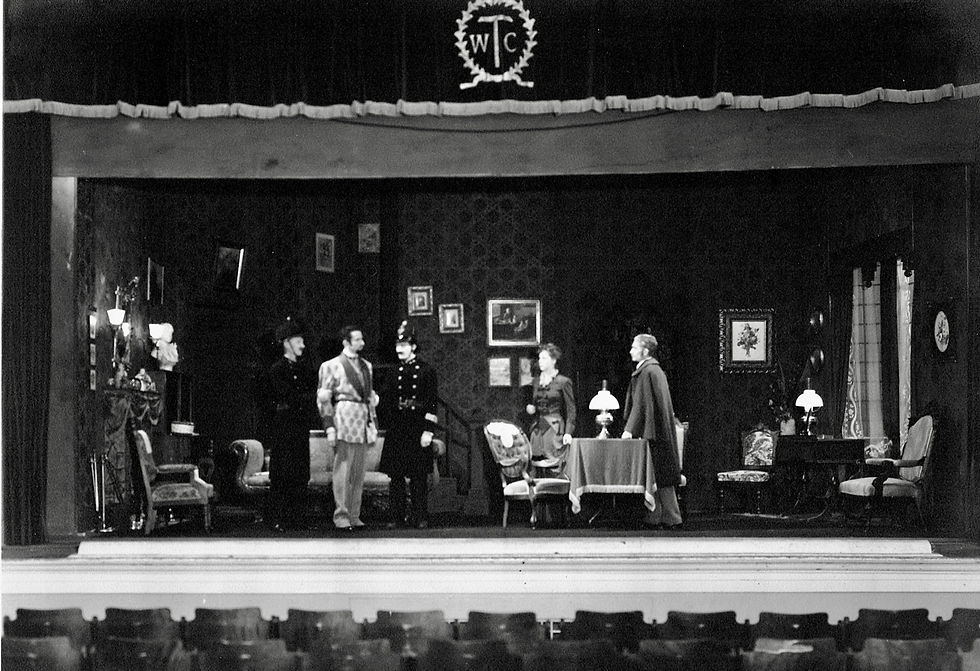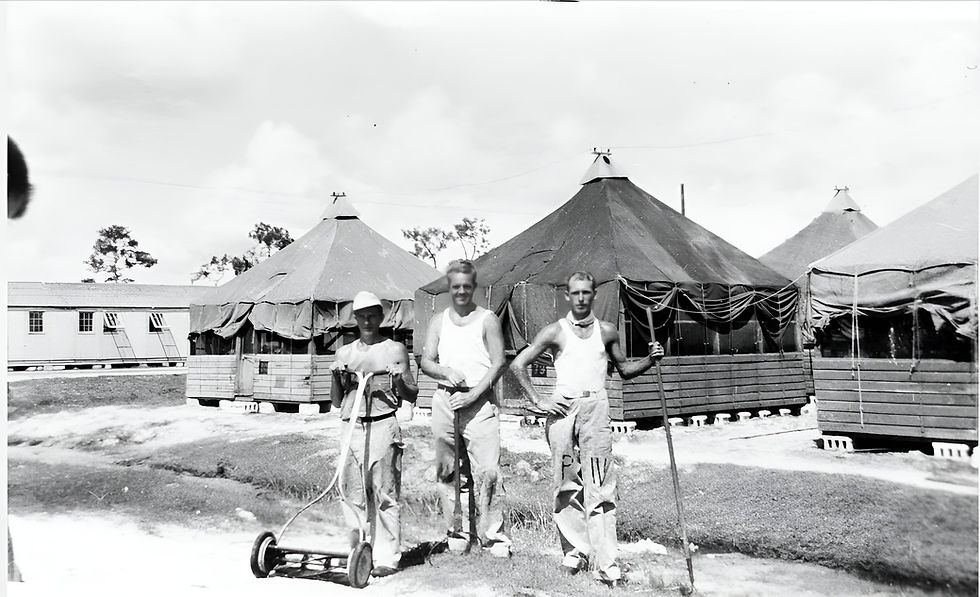Winter Haven and World War II
- Bob Gernert
- Nov 1
- 5 min read
In the early 1940s Winter Haven was no different than many other U.S. cities as its energies were directed to the World War II effort. Citizens learned what “blackouts” were (keeping lights out and/or shades drawn at night) and how to prevent both homes and businesses from becoming bombing targets at night. Air raid warnings were practiced, and a block system of communication helped individuals and families prepare for the possibility of attack. Children in schools were fingerprinted, and F. E. Brigham (school namesake) championed a new form of physical fitness education for everyone. Air raid “wardens” were appointed and helped to inspect homes to prevent fire hazards.
Children collected waste paper. Women collected cans as well as unused pots and pans, as the metal could be used in the war effort. Eight local residents attended a county wide preparedness school in Bartow.

May 1942 brought gas rationing. An air raid warning service was developed, and local volunteers served twenty-fourhour shifts on the roof of the Haven Hotel watching for unidentified aircraft. Photo depicts the Haven Hotel. During World War II, citizen volunteers atop the building watched for unidentified aircraft.
Mrs. Frank Holland served as salvage chairman for the community. Mrs. A. G. Hancock was war production chairman for the local Red Cross chapter, and other women worked around the clock to produce garments, bandages, and other items as required by the national headquarters.
The Winter Haven Herald (a now defunct weekly paper published by the Burr family) was sent on a complimentary basis to all active service men for whom they had addresses.
Another group of women headed by Mrs. Joe Nagel and Mrs. C. E. Wild learned to maintain and repair motors. People registered for sugar rationing. Many local men and women rode bicycles to work in an effort to conserve gas.

George Andrews, associated with the Haven Hotel, gave his 65- foot yacht to the government for the duration of the war. The “Furlough” had entertained many local residents on saltwater fishing expeditions.
Early in 1942, Winter Haven completed a civic center ... much of the money coming from citizen donations. It was designed to offer senior citizens a place to play cards, visit, dance, and generally socialize. The building had long been a goal of city fathers. L. H. Recker served as chairman of the building committee, Robert Kramer was treasurer, and Frank Brickman chaired the finance committee. The city had committed $7,500, and the balance of $14,397.48 raised came from donations. Upon completion there was an excess of $23.50. The Chamber of Commerce coordinated the dedication ceremony, and the Tourist and Shuffleboard Club had already moved into the building (known today as the Senior Center on Lake Silver). Later that same year, more than one hundred residents attended a Bartow meeting aimed at establishing a public health unit. A young Dr. Ivan Gessler (clinic founder) had joined Dr. W. T. Simpson in his practice and represented Winter Haven in the public health endeavor. A county referendum was required to establish such a health unit. Dr. Gessler headed an educational effort to inform the voters. On May 5, 1942, the referendum passed by a 2,000-vote margin. Gessler went on to found Gessler Clinic with N. J. Griffith, MD.
As noted in a previous column, Winter Haven arranged with the U.S. government to convert the Orange Festival grounds for use as a POW camp from 1944 to 1945.
POST-WAR WINTER HAVEN
Upon his return from the war in 1945, George Burr (founder of the Winter Haven Herald) began organizing his friends who were members of the Elk’s Lodge to join him in founding a Winter Haven lodge. By late April, 75 members had been initiated into Winter Haven Lodge No. 1972. Ceremonies were held at the Masonic Temple, then located at Fifth St. and Avenue B, SW.
Officers of the Winter Haven Lodge included: John A. Lang, Exalted Ruler; Harry E. King, Esteemed Leading Knight; George L. Burr, Esteemed Loyal Knight; Sidney I. Smith, Esteemed Lecturing Knight; C. V. Peterson, Secretary; Roger W. Clapp, Treasurer, and Trustees, O. C. Stanley, George Andrews, and H. B. Snively. Lang appointed Collier Jones as Esquire, James B. Harrington as Tiler, and J. D. Hill as Chaplain. George W. Partin was Inner Guard.
The Lodge soon purchased the Roseart Hotel for a clubhouse. The hotel was located on Third Street at Avenue B, NW on the present site of the Winter Haven Ambulatory Surgery Center. The Roseart was built during the 20s boom and once boasted, “The World’s Only Hotel with a Radio in Every Room.”

The City Commission ordered 250 parking meters for placement on the downtown business streets.
Phil Lucey was hired as manager of the postwar Florida Orange Festival and plans soon developed for a massive new exposition. The festival site stretched from what is now the site of City Hall to Lake Silver. From City Hall to Lake Silver, Third Street NW is much wider than most other downtown streets. That is because prior to the current municipal complex in that area, Third Street became the carnival midway during the Orange Festival. The Lake Silver Amphitheater was completed in 1949.
The Buffalo Bisons Baseball Team trained here in the spring of 1946. They were brought to Winter Haven by the Chamber of Commerce Baseball Committee chaired by J. H. Fuller.
Frank Sparrow was sent here from Lakeland following three years in the U.S. Navy. Sparrow had managed theaters before the war and came to Winter Haven managing both the Ritz and Grand Theaters. The Grand Theatre stood at the junction of Pope (formerly Grand) Avenue and Fifth Street, NW, just north of what was once known as the Red Cross building.

In the summer of ‘46, plans were underway for Winter Haven’s Little Theatre. R. McDonald Brown spearheaded the effort. It was called the Winter Haven Community Playhouse, and the Woman’s Club allowed their Lake Howard building to be used for their productions.
Two Race brothers, Austin Jr., and Charles, founded Race & Race, Inc. The company developed an aluminum products plant to manufacture such items as citrus irrigation pipe and picking ladders. The brothers were sons of Austin Race, Sr. The plant was located on Highway 17 North between Winter Haven and Lake Alfred. Portions of the site are now a part of the “Chain of Lakes Trail.” This property is just southeast of the Hartridge/Conine canal.
Portions of this information were taken from “The History of Winter Haven” by Josephine Burr, period newspapers, and interviews with area residents.





